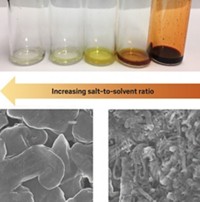Advertisement
Grab your lab coat. Let's get started
Welcome!
Welcome!
Create an account below to get 6 C&EN articles per month, receive newsletters and more - all free.
It seems this is your first time logging in online. Please enter the following information to continue.
As an ACS member you automatically get access to this site. All we need is few more details to create your reading experience.
Not you? Sign in with a different account.
Not you? Sign in with a different account.
ERROR 1
ERROR 1
ERROR 2
ERROR 2
ERROR 2
ERROR 2
ERROR 2
Password and Confirm password must match.
If you have an ACS member number, please enter it here so we can link this account to your membership. (optional)
ERROR 2
ACS values your privacy. By submitting your information, you are gaining access to C&EN and subscribing to our weekly newsletter. We use the information you provide to make your reading experience better, and we will never sell your data to third party members.
Materials
Algae Gum Amps Li-Ion Batteries
Inexpensive natural binder compound boosts electrode performance
by Elizabeth K. Wilson
September 12, 2011
| A version of this story appeared in
Volume 89, Issue 37
Lithium-ion battery technology may get a boost from a gummy substance commonly found in brown algae (Science, DOI: 10.1126/science.1209150). Traditional graphite electrodes in Li-ion batteries suffer from storage capacity problems and short lifetimes. Additionally, graphite electrodes are bound with toxic and environmentally unfriendly polyvinylidene fluoride, which further requires toxic solvents such as N-methyl-2-pyrrolidone. Scientists would like to replace graphite with silicon, which is cheap, plentiful, and has 10 times the theoretical charge capacity of graphite. However, silicon degrades rapidly during operation. Gleb Yushin of Georgia Tech, Igor Luzinov of Clemson University, and their colleagues show that the algal compound, alginate, which is commonly used in dentistry and as a food thickener, greatly stabilizes Si-based electrodes. They combined silicon nanopowder with the nontoxic alginate to create a battery anode that surpasses the reversible capacity of graphite anodes. As the authors note, alginate contains carboxylic acid groups in each of the polymer’s monomeric units. “The higher content of carboxylic groups in the binder should lead to a larger number of possible binder-Si bonds, and thus better Si electrode stability,” they write. They found that the alginate binder also works well with graphite electrodes.





Join the conversation
Contact the reporter
Submit a Letter to the Editor for publication
Engage with us on Twitter